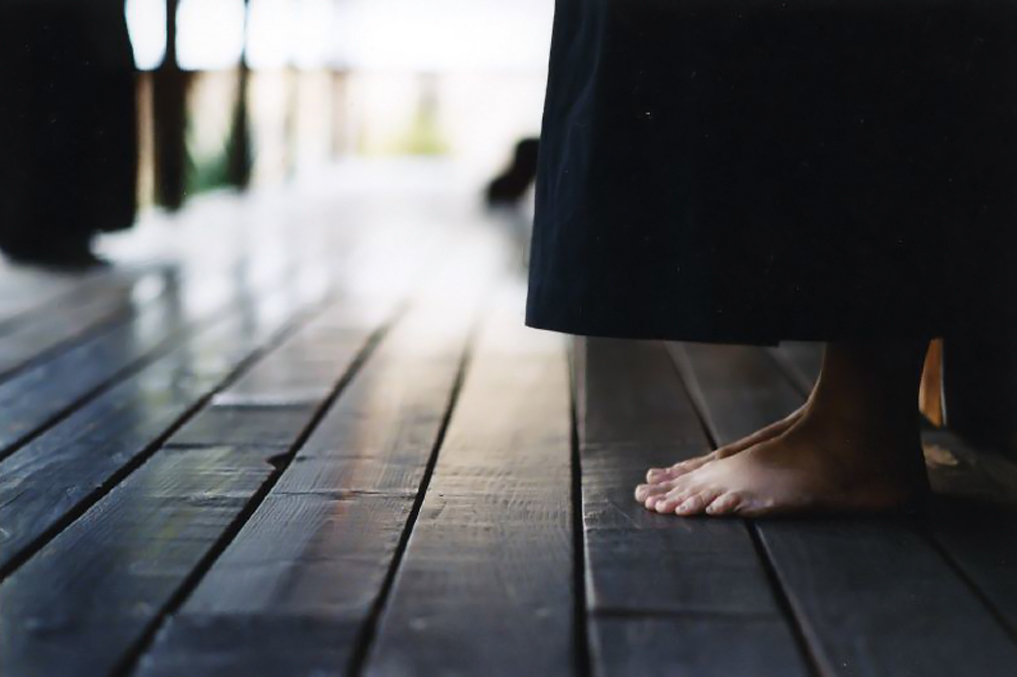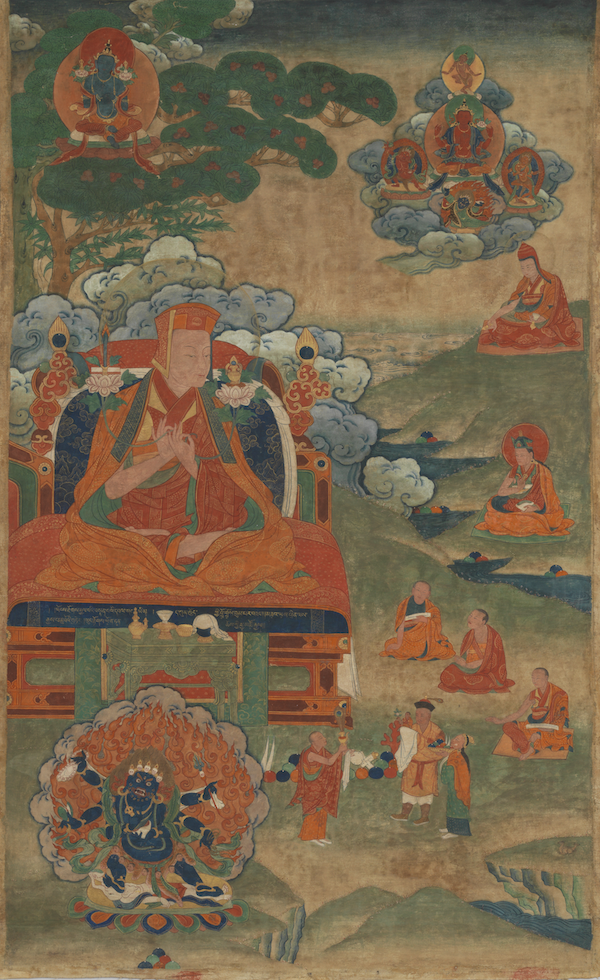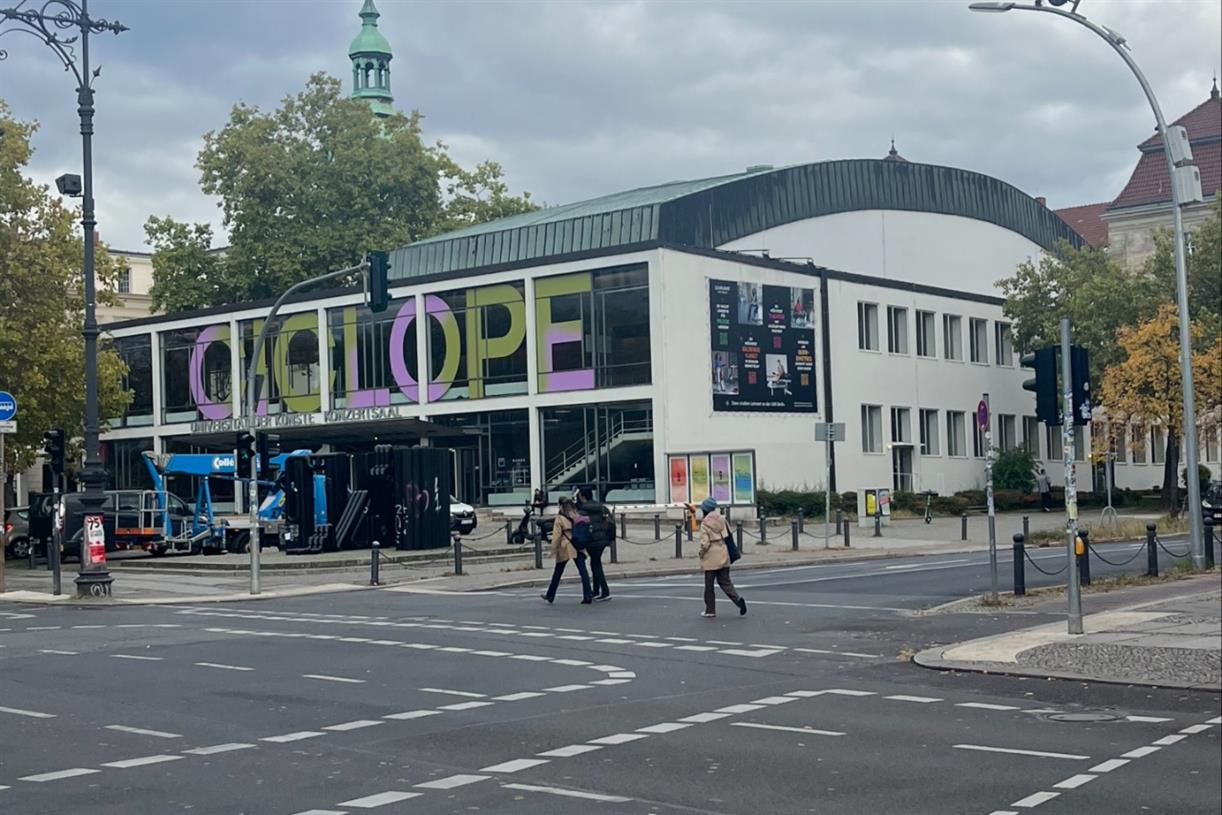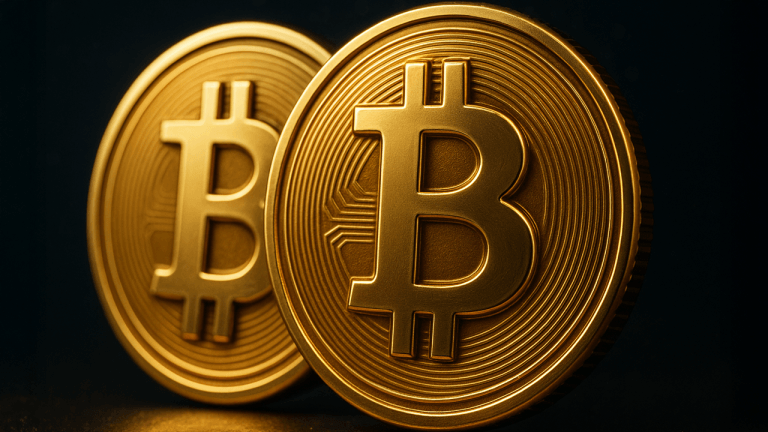Our Storied Bodies: The Interweavings of Coming In
Hilary North-Ellasante examines how our bodies hold on to suffering and what it can tell us about our experience. The post Our Storied Bodies: The Interweavings of Coming In appeared first on Lions Roar.

Hilary North-Ellasante examines how our bodies hold on to suffering and what it can tell us about our experience.

Photo by Alexander Krivitskiy.
I.
Suffering is an important principle in Buddhism. I can’t proclaim a deep understanding of the Buddhist sense of the word, but in my life, suffering has been synonymous with living. Being human is to suffer, and being human includes living amidst the oppressive realities of the world, inhabiting a mortal and aging body, cultivating a receptive soul, and connecting with the vulnerability of all things. I have lived and survived this truth, yet, sometimes, especially recently, the suffering feels like more than I can handle. And I realize I haven’t trained myself (or been trained!) well enough to be a sustainable container for suffering within my own life, or the suffering I witness among my fellow humans and all our living relations on this planet.
What might suffering teach me?
When I feel drawn into despair and hopelessness, I often try to pivot toward curiosity: What can I learn in witnessing so much suffering? What might suffering teach me? How may I embrace and move through the growing pains that accompany this process? As I dance across the surface of some ideas and insights, I simultaneously honor that these are expansive life questions, far bigger than my own existence, even when they feel particularly relevant to what’s going on right in front of my face. Coming to peace with the “not knowing” feels like an important part of the journey. But how can we also tap into the Knowing that is within us, buried in our very bodies? And how can that process aid us in “getting free” as some descendants of enslaved Africans say it? Because I am certain that it does.
II.
This spring our baby suffered a traumatic birth requiring extensive resuscitation. Witnessing what at the time appeared to be her lifeless arrival was one of the most painful experiences my Black multiracial, transracially adopted, queer, nonbinary, cancer-scarred body has endured—as a parent, as a partner, as a human. Suffering and scarring are written deep within me as a result. In processing the grief in those earliest moments and searching for some kind of meaning, I have come to know that our daughter’s little body was stunned by the acute violence of medically induced labor and technological interventions, both symptoms of an oppressive birthing system that led to a birth that veered sharply off course from the one my partner and I had planned and dreamed of for months. The abruptness of being forcibly pulled out of the dark warmth and safety of my partner’s body and into the harsh light and cold air of the hospital stunned our baby’s heart and lungs, and they stopped working. After four excruciating minutes receiving lifesaving support, our baby returned and came back into her physical body. Many minutes later, when I was first able to meet her, touch her, and look into her eyes, I was captivated by her unmistakable presence. My heart was instantly ensnared. Despite the shock of her arrival, she was so in her body. And the rhythmic little sounds she uttered were more than just cries. I instantly recognized them as stories that she was already telling about her journey to get to us. Within minutes of transitioning from in-utero life to life in the outside world, she already had wisdom to share. She had already been marked by suffering. She was already my teacher.
III.
As a Black multiracial, transracially adopted person, I know something about the suffering and trauma of birth and the suffering that can mark us from our earliest moments in our bodies. My body began collecting stories of oppression long before I was even born. There is the story of my white birth mother’s accidental pregnancy from an illicit interracial romance with my Black birth father. There is the story of the shameful threat a Black-bodied baby posed to my unapologetically racist white birth family. There is the story of banishment and the months of isolation my birth mother endured in a Catholic home for “unwed mothers,” knowing each day that our shared journey would end in separation and abandonment. My birth mother labored alone in the hospital and relinquished me to foster care at one week. Despite the courageous efforts of my paternal grandmother to keep me, I was separated from my Black birth family at the insistence of my white maternal grandmother. My adoption at one month was to white parents who, despite the most earnest of intentions, could not shed the impacts of whiteness on their own bodies and provide me, a Black-bodied child, a sense of safety, understanding, or rootedness in my Blackness.
Learning how to tune in to the experiential intelligence of my body-mind, I have begun the process of bringing forth and coming into my truth.
These are some of the earliest stories of suffering my body absorbed. Unlike stories that are celebrated and spoken in community spaces, shared by family members over meals, or intentionally captured and documented in writing, the stories I refer to are cellular, energetic, nonverbal stories. Like a sponge, my body, and the bodies around me, soaked them up without intention or awareness. But awareness can emerge over time. A tightness in my gut, unintentionally holding my breath, profuse sweating—these are just some of the uncomfortable signs that there is something in my body that needs attention. My Syrian rabbi friend contends that our bodies don’t gaslight us, and I believe her. As my awareness of the sensations and impacts of the silenced stories within me grows, I long to surface them; I am acquiring the tools.
Like digging up ripe vegetables with a spade or trowel, the surfacing of my stories requires a somatic practice of unearthing. For me, VIMBASI practice, as taught by psychotherapist and author Resmaa Menakem, trauma therapist and somatics educator Karine Bell, and coach and facilitator Erin Trent Johnson, has been one such process of noticing all the textured sensory messages my body offers when I take the time to tune inward. VIMBASI is an acronym for Vibes, Images, Meaning, Behaviors, Affect and Emotions, Sensations, and Imagination. VIMBASI is used for describing, in Resmaa’s words, the “more than cognitive” intelligences present in the body that, with practice, can provide greater access to our embodied truths. They include vibes, images, meaning making, behaviors, sense, and imagination. In Buddhism there is a similar component to mindfulness practice called vedana, which is centered on observing how the body feels, and noticing how physical sensations can bring increased consciousness to subsequent actions.
Learning how to tune in to the experiential intelligence of my body-mind, I have begun the process of bringing forth and coming into my truth. I have accepted that my path to liberation has something to do with reclaiming the stories behind the sensations, even when the process of reclaiming itself requires some suffering.
IV.
My Black multiracial, transracially adopted, queer, nonbinary, cancer-scarred body is not a refuge even though it is my steadfast vessel. Throughout my life, the presence of unspoken stories has made safety feel like an impossibility.
In fact, I had my first panic attack when I was eight years old, midway through a flight on which I was an unaccompanied minor. What I now understand to be the result of unprocessed grief and fear from my adoption that I was holding tightly within my body, in the moment it felt like a rushing, an accelerated falling, and a pounding in my chest that I was certain could only lead to a heart attack or death.
Years later, when I finally built up the courage to tell my parents what I sometimes felt in my Black body, their white bodies were neither able nor willing to acknowledge or recognize what I described. In fact, expressing that something mysterious and terrifying had happened to me was only met with more silence, more stuff we weren’t going to talk about. In the shadows of such silence, my inner world has often been a fearful place, a place of insecurity, a place I don’t readily visit. Around each psychic, soulful corner, I never know what I might find. I don’t know what might jump out at me, and when it does, I am not prepared to confront it, to receive it. Evidently, neither are the people who were responsible for my care.
And yet there is so much within me that has long desired to be received. The shame of being othered and labeled “too much” has always been one of my biggest barriers. It’s one of the forces that keeps many of these stories in the darkness of silence. The silence of a storied body is deafening. One of my fellow students of Somatic Abolitionism, an embodied anti-racist practitioner, says that shame belongs to the oppressor, and I believe her. When I internalize the dehumanizing messages that would make me feel lesser, I become smaller and less able to fight for Justice and Liberation from a place of empowerment. When I embody a lifetime of silent stories, I remain at a distance from my authentic self and my own internal repository of ancestral wisdom.
V.
In an episode of Prentis Hemphill’s podcast Finding Our Way, author Alexis Pauline Gumbs talks about ancestors and building a daily practice of coming into awareness of ancestral wisdom and impact. Because I was intentionally disconnected from my heritage and from my people as an adopted person, ancestral knowledge can be a painful topic for me. But I have been playing with the idea that all of my manifestations over the course of my lifetime weave together into a kind of tapestry of inner voices and inner selves—my inner child, my conscious self, my subconscious self, my aging self, among other selves. I realize that in embracing the wisdom of my collective selves, I become my own ancestor that has wisdom to bear. And I can also claim that much of what lives within me has lived in others who came before me—whether I knew them or not. These ancestral connections—internal and external—are mine as they are all of ours to claim. In our collective claiming, we open pathways for our collective liberation. When we integrate our awareness that our existence in the present is the result of survivorship, we shift the possibilities for safety. We have already suffered and survived—as have our ancestors—and safety is available in this ancestral truth. The practice of Somatic Abolitionism helps us lean into a new relationship to our inner truths, a relationship that, along with acknowledging and releasing the suffering, can also include safety.
VI.
Living at the intersections of multiple margins requires constant vigilance and attunement to that which threatens one’s survival. And survival depends on continuously assessing the environment for safety, constantly observing and analyzing the continuum of social variables from the micro internalized and interpersonal levels to the macro systemic realities of oppression. Throughout my life, that work of vigilance has been constant and exhausting, always drawing my attention away from energetic commitments to creativity, joy, and pleasure. Living in such a self-protective way can make the act of looking inward feel like a kind of luxury, or perhaps even a threat, a lowering of the guard. What will happen if I take my eyes off that which seeks to destroy me and turn my gaze inward?
Mindfulness practices, both Buddhist and secular, direct the gaze inward; this can be vulnerable for all who practice, but particularly for those who practice at the intersections of oppression. Mindfulness is therefore a courageous act, though it’s not often presented as such. While I am drawn to the idea of mindfulness, I am often repelled by the appropriated white/cis/heteronormative containers in which it often appears, and that has always created an access issue for me—and, I imagine, for many others. The inaccessibility of mindfulness practice is deeply intertwined with the multiply marginalized body I inhabit. Dropping into myself is neither simple, nor an inherently safe endeavor. For me turning inward has to begin with some kind of tangible reassurance.
Orienting to the space, a practice I learned from Karine Bell, is a practice in tangible reassurance. I begin by feeling the floor under my feet and connecting to the support of the earth below me. This grounds me to the presence of place and the power of the land. I slowly turn my head to perform a 360-degree scan of my surroundings, noticing where all the windows and doors are, taking in awareness of all the exits, ensuring there is a clear escape route. Like the real threat faced by my enslaved ancestors, I carry ancestral fears that need to be quelled. When I know I have the option to flee, only then can I begin to consider increased vulnerability. I also know that an increased sense of safety is on the other side of ancestral claiming, of coming into my own storied body. I desire that for myself and for all my fellow humans who journey toward Freedom.
If mindfulness practice is to become more accessible to all of us, more of a liberatory practice, it must embrace the tensions of storied bodies at the margins. It must be anchored, at least in part, to safety, survivorship, and ancestral wisdom.
VII.
Storytelling involves the voice. Sometimes that voice resonates in the throat; but there are other voices in the body, voices that may need different channels to emerge, different ways of listening—like somatics. As a queer body, I know all about holding voiceless, secret stories—stories about illicit desire that threatens heteronormative acceptability. Since my teenage years, my queer body has spiraled through a recursive emergence that began with a commitment to courageous listening, to allowing myself to listen to the stories my inner voices were telling me about love and desire, about who I was at my core: a queer person open to loving a wide continuum of humans. As much as I celebrate and see the limitless possibilities in my queerness, the process of coming out, extending beyond myself and sharing my truth with others, has compelled me to confront some of my deepest fears around rejection, abandonment, and physical safety. Even in the afterglow of Pride month, when hypervisibility feels more possible for many queer folks, I don’t explicitly come out to just anyone, even if my queer presentation obviously rejects heteronormativity. Coming out equates to exposure—a calculated risk I make each time I must decide whether or not to gift the awareness of this part of myself to a new person. And it is a gift, a precious one that, upon receipt, deserves to be revered as a confirmation of our shared humanity.
Coming out always contains the potential energy for more freedom, and so does the process of coming into our embodied selves. The collective work of acknowledging suffering, claiming ancestral wisdom, and giving voice to our storied bodies is an opportunity for coming in—to deeper self-awareness, authentic selfhood, Truth, and Freedom. Somatic Abolitionism begins with the revolutionary act for marginalized bodies of noticing. Acknowledging what is present is a powerful antidote to gaslighting, erasure, and eradication. Tuning in to my internal messaging requires that I turn down the volume on my thinking mind and tune in to my body-mind. As I focus inward, I may shiver or experience a feeling of constriction in muscles throughout my body.
Sometimes I can invite a release of tension and experience a softening through my breath or some intentional shaking. Heat is almost always present when I am digging up oppressive material. The sharp scent of my sweat provides an olfactory signal of detoxification and the releasing of impurities. Together with all of these sensations, that scent tells a story. Of resistance and survival. Of the truth of suffering. I am learning to listen more deeply to the stories my body tells, a process that is not without fear, doubt, or insecurity. When I break the silences within me, I come into attunement with all that is within and surrounding me—including and especially, the reality of suffering. Mindfulness practices that are also liberatory support the awareness and acceptance that suffering is just another one of the multicolored threads in the storied tapestry I am weaving toward “getting free.”
This article was created in collaboration with Buddhist Justice Reporter (BJR), founded by BIPOC Buddhist practitioners in response to the police torture and murder of George Floyd. BJR publishes articles on issues related to environmental, racial, and social justice and its intersections, from an anti-racist Buddhist lens.

 Lynk
Lynk 































